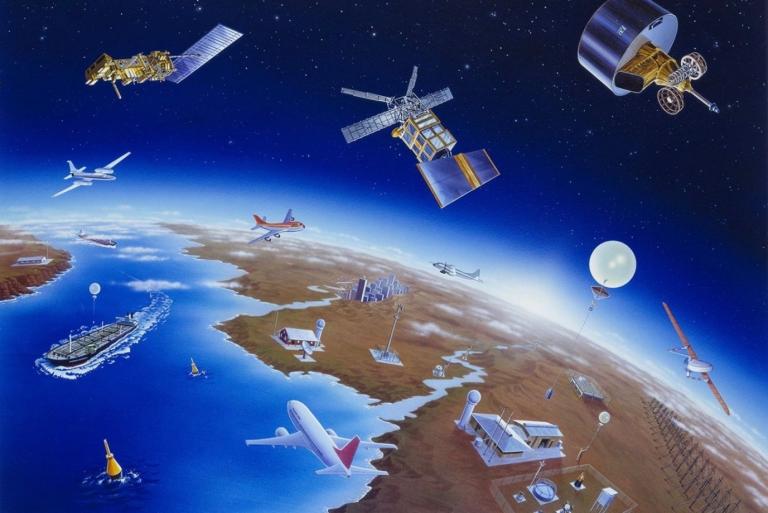Protect our radio frequency bands, says WMO
Radio frequency bands are vital for all weather forecasts and life-saving early warnings, for climate monitoring and for prediction of “space weather.” They must be protected from harmful interference in the face of increased competition from emerging technologies, according to the World Meteorological Organization (WMO).
- World Radiocommunication Conference will decide on future of radio regulations
- Radiofrequency bands are essential for Earth observations
- Weather forecasts, early warnings and climate monitoring depend on them
- Emerging technologies put increasing pressure on radio frequency spectrum
- Monitoring of sea surface temperatures and space weather in focus

WMO is seeking safeguards for essential radio frequency bands at the World Radiocommunication Conference, WRC-23, organized by the International Telecommunication Union (ITU) from 20 November to 15 December in Dubai. The conference will update the Radio Regulations, the global treaty governing radio spectrum and satellite orbits.
"Access to the radio frequency spectrum is critical to the meteorological and hydrological infrastructure that underpins weather and related environmental services worldwide. Satellites, weather radar, radiosondes, hydrological observing systems, and drifting buoys all operate based on radio or microwave transmissions," says WMO Secretary-General Prof. Petteri Taalas.
“The safety of life and property depends on weather and environmental forecasts. Extended warning times for severe events enable citizens, civil authorities and first responders to act."
“Only by working together can we — the global meteorological and radiocommunication communities — maintain and improve our future capacity for Earth observation and the vital services that depend on it,” Prof. Taalas wrote in the ITU News magazine.
WMO and ITU enjoy longstanding collaboration on meteorology data and digital technologies. Both are partners in the Early Warnings For All initiative spearheaded by UN Secretary-General António Guterres to ensure everyone on Earth is protected from climate hazards and disasters through life-saving alerts by the end of 2027.
WMO is therefore appealing to ITU members to respect the meteorological community’s requirements for radio-frequency allocations and regulatory provisions at WRC-23.
Specifically, it is essential to fully apply Article No. 5.340 of the Radio Regulation, which prohibits all radio emissions in specified frequency bands between 1400 MHz and 252 GHz. Weather, water and climate research and operations all depend on preserving these as emission-free bands.
From a meteorological and climate-monitoring perspective, the most critical issues are concerned with the measurement of sea surface temperature and the observations of space weather.

Technical background
Sea surface temperature (SST) is a vital component of the climate system, with a major influence on interaction between oceans and the atmosphere. SST, as one of the main drivers of ocean circulation, is crucial for numerical weather and ocean prediction models. The 6/7 gigahertz (GHz) frequency range — corresponding to peak SST sensitivity — is currently being utilized for passive ocean remote sensing from satellites.
One of the items on the WRC-23 agenda 1.2 proposes the identification of frequency bands for International Mobile Telecommunications (IMT) within the 6/7 GHz range, even though studies demonstrate that SST measurements could be severely hindered by such deployment.
To mitigate this risk, WMO has identified other potential bands for SST measurement that could be used in combination with the 6/7 GHz range. To ensure long-term continuity, WMO urges administrations to consider, at WRC-23, new primary EESS (passive) allocations in the 4.2–4.4 GHz and 8.4–8.5 GHz bands for SST measurement.
Space-weather observations are essential for, in particular, the detection of solar events which can cause severe disruptions to critical infrastructure both on Earth and in space, resulting in radio blackouts, damage to satellites, perturbations in power grids, and increased radiation exposure on trans-polar aircraft routes.
Despite the need to anticipate hazardous space weather events, the current Radio Regulations contain no recognition or provisions related to space weather observations.
The WRC-23 is set to discuss appropriate recognition of space weather sensors in the Radio Regulations. WMO is advocating for a two-step approach at WRC-23:
- Step 1:
Define space weather in the context of the Radio Regulations and associate space weather with the appropriate “radiocommunication service” under which space-weather systems may operate – namely the meteorological aids (space weather) service, or in short: MetAids (space weather).
- Step 2:
Develop a new WRC-27 agenda item proposing new MetAids (space weather) allocations in frequency bands used by operational space-weather sensors that require protection.
Notes to Editors
Read about WMO’s position in ITU News special edition on Science services : Earth observation at the World Radiocommunication Conference
The World Meteorological Organization (WMO) is a specialized agency of the United Nations responsible for promoting international cooperation in atmospheric science and meteorology.
WMO monitors weather, climate, and water resources and provides support to its Members in forecasting and disaster mitigation. The organization is committed to advancing scientific knowledge and improving public safety and well-being through its work.
For further information, please contact:
- Clare Nullis WMO media officer cnullis@wmo.int +41 79 709 13 97
- WMO Strategic Communication Office Media Contact media@wmo.int

